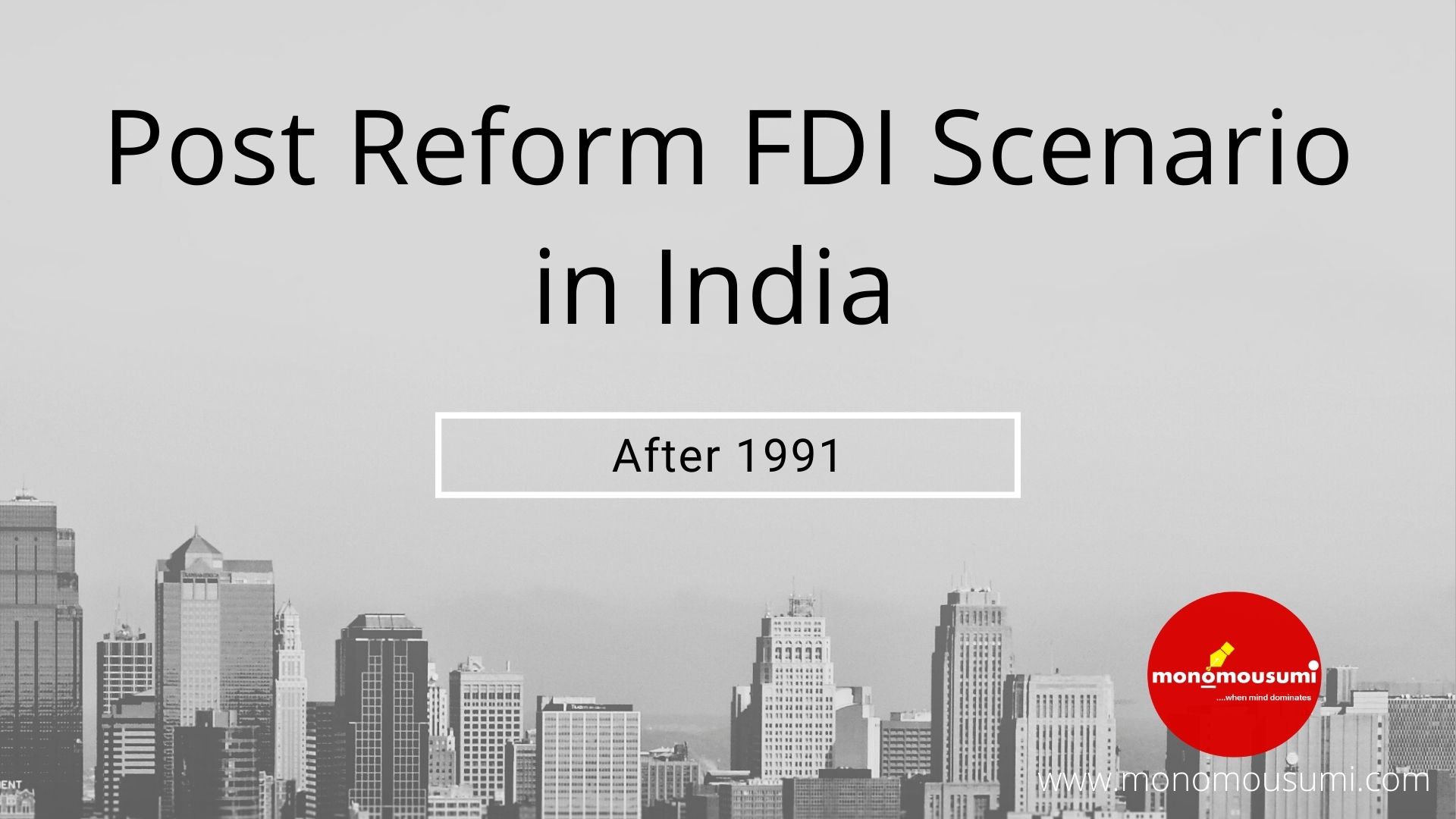
Authors: Adarsh Agrawal, Anjali Negi, Saumya Gupta, Subhavi Gupta
BACKGROUND
Foreign Direct Investment was introduced in 1991 in India under the FEMA (Foreign Exchange Management Act), driven by then Finance Minister of India, Dr. Manmohan Singh. It started with a base of 1 billion dollars in the year 1990.
With the Industrial Policy Statements of 1980 and 1982, followed by the Technology Policy Statement in 1983, the government started liberalizing FDI in 1980-91. This era also witnessed a substantial degree of trade liberalization in terms of tariff reductions and the transformation from licensing to the Open General License (OGL) category of several important commodities. Over the first half of the 1990s, FDI emerged for the first time, as a favored route for mobilizing financial capital and resources over loans and other types of financial channels. Under the automatic approval route, foreign equity of up to 51 percent was approved by the RBI in stated industries producing intermediate and capital goods. FDI was viewed as an instrument to put in international technology that was not accessible and available domestically and which eventually replaced the term ‘indigenous’ with ‘sophisticated and high technology’.
A contrast of the four-country tax policy with that of India’s tax policy shows that these countries have focused on a certain minimum amount of FDI in order to benefit from tax exemptions. India’s FDI policy, on the other hand, discouraged long-term investment until 2000 unless there existed a very significant and large export commitment and was comparably backward in the renegotiation of the tax treaties. While some countries placed restrictions on foreign ownership, the relaxation or tax concessions are related not only to export performance but also to important domestic policy matters such as employment, location, and local content.
After the year 1995, India’s foreign investment policy was greatly impacted by the Uruguay Agreement of 1995, in which it was no longer possible to handle foreign companies on less favorable terms. Also, the communication industry’s revolution created a whole new range of firms that were listed in terms of FDI regulations as ‘industries’.
Some of the measures proposed to promote FDI in India post-1991 are as follows:-
- Implementation of a dual-route: The automatic route of RBI, and The approval route of the government.
- Automatic authorization for technology agreements in high-priority sectors and elimination of restrictions in low-technology areas as well as liberalization of imports of technology.
- Approval to invest up to 100% in high priority sectors for NRIs and overseas corporate bodies.
- Hike of up to 51% in foreign equity participation for existing companies and liberalization of the usage of foreign ‘brand name’.
- Signing and forming a Multilateral Investment Guarantee Agency for the security of Foreign Investments.
These initiatives resulted in a substantial increase in FDI, even as portfolio investment decreased after 1997 due to the East Asian crisis. In order to further promote FDI, under the automatic route for the infrastructure sector which comprised of power supply, roads, ports, and harbors, etc. foreign equity participation of up to 100% with a limit of about 15 billion was allowed.
SCENARIO
The high market attractiveness of India captures more FDI in the upcoming years. However, in the view of the current COVID-19 situation, India is attracting FDI at a higher rate under the approval route of the government. Moreover, According to the Department for Promotion of Industry and Internal Trade (DPIIT), FDI equity inflow in India stood at US$ 469.99 billion from April 2000 to March 2020, signaling that the proposed measures to improve FDI promote ease of doing business and loosening FDI norms has yield positive outcomes.
Today, India is regarded as an essential destination for foreign direct investment. Telecommunications, construction activities, and computer hardware & software applications are the main sectors that attract a significant chunk of overseas investment.
According to (India Brand Equity Foundation, 2020), FDI equity inflow in India stood at US$ 49.97 billion in 2019-2020. In India, statistics for 2019-20 reflect that the service sector attracted the highest FDI equity inflow of US$ 7.85 billion, followed by computer software and hardware at US$ 7.67 billion, the telecommunication sector at US$ 4.44 billion, and trading at US$ 4.57 billion.
In the year 2019-2020, India received the maximum FDI equity inflow from Singapore: US$ 14.67 billion, followed by Mauritius: US$ 8.24 billion, Netherlands: US$ 6.50 billion, USA: US$ 4.22 billion, and Japan: US$ 3.22 billion.
Therefore, If one intends to invest through FDI, one must know about the various types of FDI (with examples). With FDI, it is possible to use the money invested to start a new business in a foreign country or invest in an established and already running business overseas.
Some of the common types of FDI in India post-1991 are as follows:-
- Horizontal FDI: Horizontal FDI, which mainly revolves around investing funds in a foreign business belonging to the same industry as that owned or run by the investor in the FDI, is the most common form of FDI. Under horizontal FDI, a company invests in a company situated in another country, in which both the companies manufacture similar products. For example, Zara, a company based in Spain, may invest in or purchase Fab India, an Indian company that also produces similar products. As both firms belong to the same merchandise and clothing sector, such FDI is known as horizontal FDI.
- Vertical FDI: A vertical FDI happens when an investment in a business, which may or may not necessarily belong to the same sector, is made within a typical supply chain. As such, a business invests in a foreign firm that can supply or sell goods, when vertical FDI occurs. Vertical FDIs are further classified as backward and forward vertical integrations. For example, Nescafe (Swiss Coffee producer) might invest in countries like Brazil, Columbia, Vietnam, etc. for coffee plantations. This form of FDI is known as backward vertical integration since the investing company buys a supplier in the supply chain. Contrarily, forward vertical integration occurs when a company invests in another foreign company, which is positioned and ranked higher in the supply chain. For example, a coffee company in India would choose to invest in a French grocery brand.
- Conglomerate FDI: The deal is known as conglomerate FDI if investments are made in two totally separate companies from completely different industries. As such, FDI is not explicitly related to the investors’ business. For example, the US retailer Walmart might invest in TATA Motors Company, the Indian manufacturer of automobiles.
- Platform FDI: Platform FDI is the last category of foreign direct investments. A business expands into a foreign country in the case of a Platform FDI, but the goods produced are shipped to another, the third country. For example, The French perfume brand Chanel has set up a production plant in the United States and exports the final product to other countries in Asia, America, and parts of Europe.
Some of the current FDI inflows in India are as follows:-
India received the highest cumulative Foreign Direct Investment (FDI) ever for the first five months of a financial year in April-August 2020, the Minister of Commerce and Industry said in a statement.
Over the first five months, the overall inflow of FDI into India was $35.73 billion, 13 percent higher than in the same period last fiscal year. The inflow of FDI equity earned during FY21 (April to August 2020) is $27.1 billion. For the first five months of a financial year, it is also the highest ever, the Ministry said. This is 16 percent more than the $23.35 billion inflows seen in the first five months of 2019-20.
Stating that these trends are an acknowledgment of India’s standing and status among global investors as a favored investment destination, the government said that the measures are taken by them w.r.t. FDO policy reforms, investment facilitation, and ease of day-to-day business have resulted in increased FDI inflows into the nation.
In the first quarter of 2020-21, total FDI to India plunged by 60% from the year-ago to $6.5 billion in data released by the Department for Promotion of the Industry and Internal Trade (DPIIT) was much worse than the global forecasts of the United Nations Conference on Trade and Development (UNCTAD).
In March, the agency revised its estimates concerning the effect on global FDI of the outbreak and spread of Covid-19. In FY21, the multilateral organization expects the downward pressure on worldwide FDI to be -30 percent to -40 percent, which is far higher than its previous estimate of -5 percent to -15 percent pressure.
According to the release, the aim of the government is to make the FDI policy more investor-friendly and eliminate the policy bottlenecks that have hampered the country’s investment inflows. The steps taken in this regard have borne fruit over the last six years, as is evident from the ever-increasing volumes of FDI inflows received into the nation, it said.
Total FDI inflows increased by 55 percent from $231.37 billion in 2008-14 to $358.29 billion in 2014-20, while FDI equity inflows increased by 57 percent from $160.46 billion in the same period to $252.42 billion.
REFERENCES
- Azhar, S., & KN, M. (2012, February). An Overview of Foreign Direct Investment in India. EXCEL International Journal of Multidisciplinary Management Studies, 2(1). https://www.researchgate.net/publication/271729440_AN_OVERVIEW_OF_FOREIGN_DIRECT_INVESTMENT_IN_INDIA
- CFI. (n.d.). Foreign Direct Investment (FDI). Corporate Finance Institute. https://corporatefinanceinstitute.com/resources/knowledge/economics/foreign-direct-investment-fdi/
- Chaturvedi, I. (2011, March 28-30). Role of FDI in Economic Development of India: Sectoral Analysis. International Conference on Technology and Business Management. http://docshare02.docshare.tips/files/10154/101541427.pdf
- Definitions & Sources. (2007). United Nations Conference on Trade and Development. https://unctad.org/system/files/official-document/wir2007p4_en.pdf
- Department for Promotion of Industry & Internal Trade. (2020, September). FDI Statistics. DIPP. https://dipp.gov.in/sites/default/files/FDI_Fact_sheet_September_20.pdf
- Devajit, M. (2012, September). Impact of Foreign Direct Investment on the Indian economy. Research Journal of Management Sciences, 1(2), 29-31. http://www.isca.in/IJMS/Archive/v1/i2/5.ISCA-RJMgtS-2012-020.pdf
- Duce, M., & España, B. d. (2004, March 30). Definitions of Foreign Direct Investment (FDI): a methodological note. Research for the Bank of International Settlements, 16. https://www.bis.org/publ/cgfs22bde3.pdf
- FDI flows. (n.d.). OECD. Retrieved November 08, 2020, from https://data.oecd.org/fdi/fdi-flows.htm
- Foreign Direct Investment, percent of GDP in Asia. (n.d.). The Global Economy. https://www.theglobaleconomy.com/rankings/Foreign_Direct_Investment/Asia/
- India Brand Equity Foundation. (2020, October). FOREIGN DIRECT INVESTMENT (FDI). IBEF. https://www.ibef.org/economy/foreign-direct-investment.aspx#:~:text=FDI%20equity%20inflow%20in%20India%20stood%20at%20US%24%2049.97%20billion,trading%20at%20US%24%204.57%20billion.
- India: Foreign Direct Investment, percent of GDP. (n.d.). The Global Economy. https://www.theglobaleconomy.com/India/Foreign_Direct_Investment/#:~:text=%3A%20For%20that%20indicator%2C%20we%20provide,from%202019%20is%201.76%20percent.
- Malhotra, B. (2014, November 1). Foreign Direct Investment: Impact on Indian Economy. Global Journal of Business Management and Information Technology, 4(1), 17-23. https://www.ripublication.com/gjbmit/gjbmitv4n1_03.pdf
- Manifest IAS. (2020, March 18). SECTOR-WISE FDI INFLOW. Manifest IAS: The Wisest Way. https://www.manifestias.com/2020/03/18/sector-wise-fdi-inflow/
- Mukherjee, A. (n.d.). Regional Inequality in Foreign Direct Investment Flows to India: The Problem and the Prospects. RBI. https://m.rbi.org.in/scripts/bs_viewcontent.aspx?Id=2597
- Nayak, S., & Sahoo, D. (2020, May 08). Dimensions of Foreign Direct Investment Inflow in India After 1991. FIIB Business Review, 9(2), 106-117. https://doi.org/10.1177/2319714520914203
- Singh, D. J., Chadha, M. S., & Sharma, D. A. (2012, October). Role of Foreign Direct Investment in India: An Analytical Study. International Journal of Engineering and Science, 1(5), 34-42. http://www.researchinventy.com/papers/v1i5/E015034042.pdf
- Srivastava, S., & Sen, R. (2004, September 01). Competing for Global FDI: Opportunities and Challenges for the Indian Economy. South Asia Economic Journal, 5(2), 233-260. https://doi.org/10.1177/139156140400500203
- What is Foreign Direct Investment (FDI)? (n.d.). Corporate Finance Institute. https://corporatefinanceinstitute.com/resources/knowledge/economics/foreign-direct-investment-fdi/
- What Is Foreign Direct Investment (FDI). (2019). Business Standard. https://www.business-standard.com/about/what-is-fdi
- India: Foreign Direct Investment, billion dollars. (n.d.). The Global Economy. https://www.theglobaleconomy.com/India/fdi_dollars/


